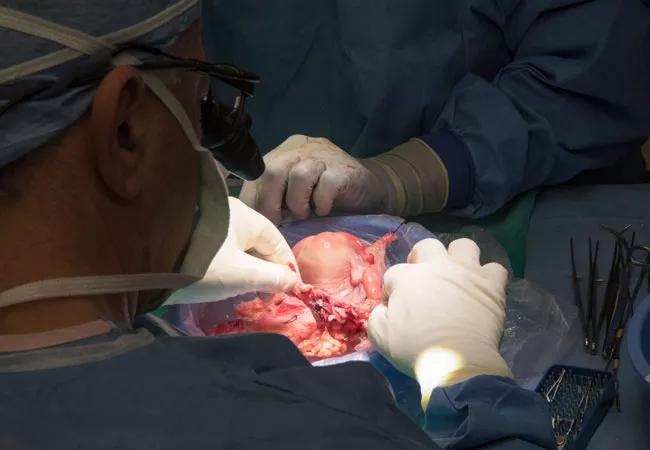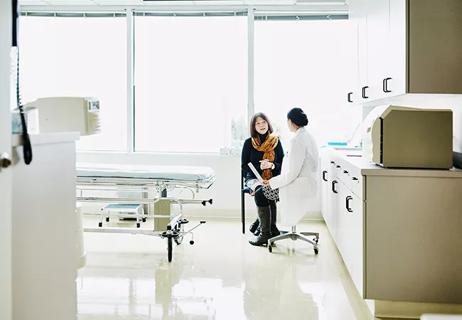Video presentation of an experimental protocol

Cleveland Clinic performed its second uterus transplantation into a living recipient in December 2017. A video documenting the procedure – and awarded First Prize for Technical Achievement in Video by the American Society for Reproductive Medicine (ASRM) – was presented today at the ASRM 2018 Scientific Congress & Expo.
Advertisement
Cleveland Clinic is a non-profit academic medical center. Advertising on our site helps support our mission. We do not endorse non-Cleveland Clinic products or services. Policy
According to the National Center for Biotechnology Information (NCBI), approximately one in 500 women suffers from absolute uterine infertility, with options for becoming a mother limited to adoption or gestational surrogacy.
“Absolute uterine factor infertility is often a devastating diagnosis for these patients, and uterus transplant is arguably the only true treatment for the condition,” explains Elliott Richards, MD, Fellow in Reproductive Endocrinology & Infertility and narrator of the video. “There is growing interest both nationally and internationally in uterus transplantation. For now the procedure is restricted to a small number of academic centers under an experimental protocol.”
Dr. Richards cautions that uterus transplantation will likely remain experimental for the next 5 to 10 years. Uterus transplant is a complex procedure, involving multiple parties, with psychological, ethical and cultural considerations. Cleveland Clinic has published extensively on these concerns and performed more than a dozen practice organ procurements. Cleveland Clinic currently utilizes a deceased donor model for its uterus transplant program.
“When a candidate expresses interest in our transplant program, our research coordinator meets with them to determine whether they meet our inclusion and exclusion criteria, which is the first of a multi-phase process,” says Dr. Richards, who notes the program has attracted an abundant pool of candidates with minimal recruitment effort.
Qualified candidates then meet with a primary investigator, fertility specialist, transplant nurse, infectious disease specialist, bioethicist, psychiatric specialist, social worker, and research subject advocate. Next, a series of tests and examinations are performed and reviewed by the medical team. In addition to a comprehensive medical workup, ongoing assessment takes place regarding the subject’s ability to understand the risks, benefits and lifestyle changes associated with uterus transplantation, in vitro fertilization (IVF) and pregnancy. If the team unanimously agrees, the patient proceeds to IVF. At least six viable frozen blastocysts must be secured before patients are put on the uterus transplant list.
Advertisement
“Incredible effort is taken to ensure constant communication and coordination among multiple care teams,” notes Dr. Richards. In the procurement surgery, the dissection and preparation of the donor uterus is performed first, though the uterus remains in situ and perfused until cross-clamping and procurement of lifesaving organs by other transplant teams. Once the uterus has been procured, it is brought to the back table in the neighboring OR. The uterus procurement team prepares the uterus while the uterus transplant team prepares the recipient. After the transplant, the patient is prescribed immunosuppressive therapy and is followed closely by many specialists. The transplanted cervix is biopsied regularly to monitor for rejection. Embryo transfer can be considered beginning at six months. Once the patient is pregnant, the delivery is performed by Caesarean section. After one or two pregnancies, hysterectomy is performed.
In the video article, Dr. Richards presents a case of a 35-year-old Caucasian female with Mayer-Rokitansky syndrome and a deceased donor 24 years of age with a history of childbearing. The team outlines transplant protocol and shares video footage of the transplant surgery as well as postoperative MRI and ultrasound imaging of the transplanted organ. For this particular case, the team is planning embryo transfer to take place by December 2018.
The transplantation team was led by Rebecca Flyckt, MD, Director of the Fertility Preservation and Cancer Program, and Tommaso Falcone, MD, who was then serving in the role of Ob/Gyn & Women’s Health Institute Chairman.
Advertisement
Advertisement

Deprivation is linked to impaired glucose intolerance and racial disparities

Artesunate ointment is safe well and tolerated patients with vulvar intraepithelial neoplasia

A case-based discussion of efficacy, eligibility and use

Workshop curriculum was valued by some, while others would have preferred time for themselves

Large randomized study compares embryo growth kinetics and live birth rates between culture media

Anatomical considerations critical to disease excision

Addressing the brain-body interplay can help patients achieve better outcomes

Cara King, DO, MS, outlines practices that can make all the difference